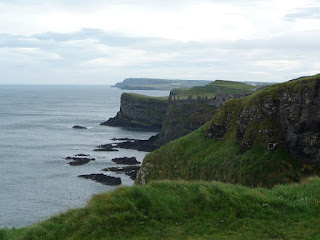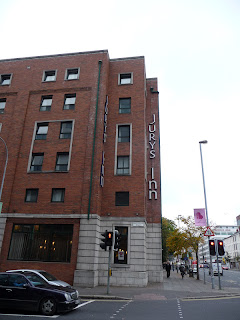Today was a beautiful day over here in Northern Ireland! Lots of sun, big puffy clouds, and warm temperatures. We did experience extreme winds on some of the cliffs by the sea.
We stayed at the Ramada Inn in Portrush last night. It was a very nice hotel. We were greeted with great views this morning from our room...
Driving along the coast was gorgeous!!
We started off the day with a stop at the Dunluce Castle ruins. You actually have to park in front of someones house in order to get to the ruins. It just so happened that was the house of the people we met yesterday on the ferry (and ate dinner with). They told us to stop in to visit but they weren't home when we got there. So after viewing the castle ruins, we went on our way for the day.
Dunluce Castle is a now-ruined medieval castle in Northern Ireland. It is located on the edge of a basalt outcropping in County Antrim and is accessible via a bridge connecting it to the mainland. The castle is surrounded by extremely steep drops on either side, which may have been an important factor to the early Christians and Vikings who were drawn to this place where an early Irish fort once stood. (Wikipedia)
We continued our drive along the Causeway's Coastal Road. It was fabulous! Sometimes we drove for miles right along side the water - beautiful!!
We stopped and walked out to the Giant's Causeway (2 miles roundtrip) - it was absolutely amazing! Pictures can't really do it justice.
The Giant's Causeway is an area of about 40,000 interlocking basalt columns, the result of an ancient volcanic eruption. It is located in County Antrim northeast of the town of Bushmills. It was declared a World Heritage Site by UNESCO in 1986, and a National Nature Reserve in 1987 by the Department of the Environment for Northern Ireland. In a 2005 poll of Radio Times readers, the Giant's Causeway was named as the fourth greatest natural wonder in the United Kingdom. The tops of the columns form stepping stones that lead from the cliff foot and disappear under the sea. Most of the columns are hexagonal, although there are also some with four, five, seven and eight sides. The tallest are about 39 ft high, and the solidified lava in the cliffs is almost 92 ft thick in places. It is the most popular tourist attraction in Northern Ireland. (Wikipedia)
Saint Patrick is recorded as having visited Dunseverick Castle in the 5th century AD, where he baptized Olcán, a local man who later became a Bishop of Ireland. The original stone fort that occupied the position was attacked by Viking raiders in 870 AD. The last one to have the castle was Giolla Dubh Ó Catháin, who left it in 1657 to settle in the Craig/Lisbellanagroagh area. The castle was captured and destroyed by General Robert Munro in 1642 and his Cromwellian troops in the 1650s, and today only the ruins of the gatelodge remain. A small residential tower survived until 1978 when it surrendered to the sea below. (Wikipedia)
Kinbane Castle is situated in County Antrim on a long, narrow limestone headland projecting into the sea. The name Kinbane means White Head and refers to the white limestone on which the castle stands. Not much of the castle remains, and the path up to it is narrow and stepped. The two story castle was built in 1547. (Wikipedia) Tracy chose to walk down to the castle. It was a bit cold and windy and I was not feeling real well, so I waited in the car and just enjoyed the view.
Views along the Causeway Coastal Road
We saw this guy fishing on a rock way out in the sea. It kind of stumped us as to how he got out there...
I zoomed in with my camera... lo and behold... it was a "dummy" set out there. That was pretty funny!!!
Still driving the Causeway Coastal Road...
Our final stop for the day was in Belfast, Northern Ireland. Belfast is the capital of and largest city in Northern Ireland. By population, it is the fourteenth largest city in the UK and second largest on the island of Ireland. Historically, Belfast has been a center for the Irish linen industry, tobacco production, rope-making and shipbuilding. The city's main shipbuilders, Harland and Wolff, built the well-known RMS Titantic. (Wikipedia)
Belfast was a very busy city. We saw some street performers.
There was a huge ship coming in...
Carrickfergus Castle is a Norman Castle, situated in the town of Carrickfergus in County Antrim, on the northern shore of Belfast Lough. Besieged in turn by the Scots, Irish, English, and French, the castle played an important military role until 1928 and remains one of the best preserved medieval structures in Ireland. It was strategically useful, with 3/4 of the castle perimeter surrounded by water. (Wikipedia)
We got to the castle about an hour before closing time. We were the only visitors there so it was like our very own castle to explore. They had a lot of displays set up to explain and show how it would have been years ago. It was pretty cool to see it all.
I know this is a blurry picture.... but it was still kind of cool...
This is King John on the "potty" - it would all just "slide" on outside the castle... "watch out below...."
We are staying 2 nights at the Jury's Inn in downtown Belfast. We were right in the middle of downtown - a very busy place with lots and lots of people. Reminded me a lot of New York City! We splurged for dinner and ate at a McDonald's near the castle before finding our hotel. It was a nice change of pace for dinner. We arrived at the hotel around 7:30 p.m. and spent the evening relaxing in our room.





















































No comments:
Post a Comment